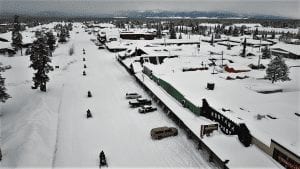
Photo courtesy of Dobson Entertainment
A Guide to Responsible Drone Use in Greater Yellowstone
Visitors journey to the Greater Yellowstone region to experience the beauty of pristine wilderness. Capturing memories of the experience is a top priority for many and recreational drones have increased in popularity among area visitors. Drones allow explorers to catch aerial footage of the surrounding mountains and—if they’re lucky—a glimpse of elusive wildlife.
Though drones can offer visitors a unique perspective of Greater Yellowstone, they can also cause stress and potential harm to area wildlife. The unfamiliar noise and activity of a nearby drone can raise stress levels in animals and cause others to break and run—with potentially dangerous consequences. In addition, an animal that attacks a drone might not only damage the drone, but also risk personal injury.
How can visitors capture that once-in-a-lifetime drone footage without harming area wildlife? A combination of laws, regulations, and guidelines place protective restrictions on drone use around wildlife in Greater Yellowstone. Drone users must follow the law and respect wildlife or risk potential fines or even jail time.

Photo courtesy of Dobson Entertainment
Know the laws
Federal law, state law, and administrative regulations all govern aspects of recreational drone use in the Greater Yellowstone region. Visitors should be familiar with the following restrictions before operating a drone in the area.
- No drones in Yellowstone National Park. The National Park Service banned recreational drone use in national parks in June 2014. This means that area visitors are prohibited from using drones once they enter the park gate. The U.S. Forest Service prohibits drone use in wilderness areas, but allows drone use on general forest lands. Visitors should consider checking in with the Hebgen Lake Ranger District office just north of West Yellowstone to pick up a map and speak to a local U.S. Forest Service ranger about drone-friendly locations.
- Register your drone. The Federal Aviation Administration (FAA) requires recreational drone operators to register their drone with the agency and display the registration number on the outside of the drone. Drone operators must also carry proof of registration.
- Follow flight guidelines. FAA regulations require recreational drone operators to fly at an altitude of 400 feet or below and keep the drone in their line of sight at all times. Drone operators are also prohibited from flying in controlled airspace around and above airports. Montana state laws prevent hunting or scouting with drones as well as drone use that interferes with wildfire suppression efforts.
- Do not harass wildlife. Montana state law prohibits wildlife harassment, which is punishable by monetary penalties and/or jail time, depending on the severity. Moreover, the federal Bald and Golden Eagle Protection Act prohibits the “taking” of bald and golden eagles, which includes molestation or disturbance. Violation of the Act can result in a $100,000 fine and up to a year in jail.

Photo courtesy of Dobson Entertainment
Respect area wildlife
If you plan to fly a drone on your next vacation to Greater Yellowstone, it’s important to be mindful of the impact of drones on area wildlife, such as eagles, elk, bison, and bighorn sheep. The noise and activity of drones can create stress and anxiety for wildlife, leading animals to react in unpredictable and sometimes dangerous ways.
“One of the biggest issues we have is bald eagle nests,” said Randall Scarlett, a wildlife biologist with the Custer-Gallatin National Forest outside of West Yellowstone. “We have quite a few around [Hebgen Lake] and at certain times they’re very vulnerable to disturbance.”
The bald eagles near Hebgen Lake nest and rear their young in the surrounding forest. When the eagles lay their eggs, nearby drone disturbance can cause them to leave their nests for longer periods of time than normal—exposing both the eagles, eggs, and any young chicks to weather or predators. In the worst case scenario, eagles will abandon their nests entirely and leave behind both eggs and young chicks.
In order to protect eagles and their nests, guidelines issued by Montana Fish Wildlife & Parks call for a buffer zone of a quarter-mile around and 1,000 vertical feet above bald eagle nests during breeding season. However, the U.S. Forest Service does not publicize the locations of bald eagle nests around Hebgen Lake, so recreational drone operators must be especially cautious when using drones in the area to avoid disturbing the resident eagles.
Other area wildlife, such as bison, elk, or deer, might break and run if they encounter a drone. “At some point animals recognize that there’s something out of the ordinary and they will break and run,” said Scarlett. “At that point it’s harassment.”
Animals that break and run expend energy that they could otherwise conserve. They also risk injury or separation from their young. Pronghorn antelope, mountain goats, and bighorn sheep are notably sensitive and may react to seemingly distant drone disturbances that wouldn’t impact other animals. Pronghorn antelope, in particular, are very lightly built and are susceptible to injury if they break and run. Serious injury can also occur if bighorn sheep or mountain goats slip or fall from the steep cliffs they call home.
Animals that don’t break and run or show visible reactions to drone use may still experience significant stress. For example, a 2015 study by a group of Minnesota researchers found that the presence of a drone caused black bears’ heart rates to skyrocket—including the heart rate of a bear denned for hibernation. Chronic stress on wildlife from drone disturbance can have unforeseen impacts on the health and wellbeing of the Greater Yellowstone ecosystem.
Drones can produce breathtaking imagery for area visitors, but it’s important that operators abide by drone rules and guidelines in order to protect vulnerable wildlife. Responsible drone use can help ensure a healthy environment for future generations of area explorers. “Know the FAA regulations and use common sense,” recommends Scarlett. “Understand that [you] might want to get a picture or video of an animal, but at what cost?”